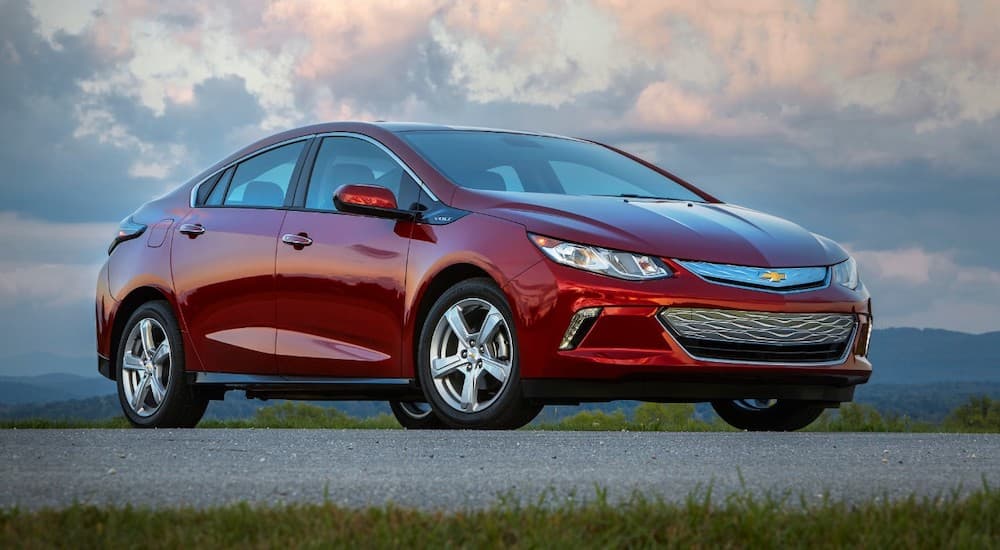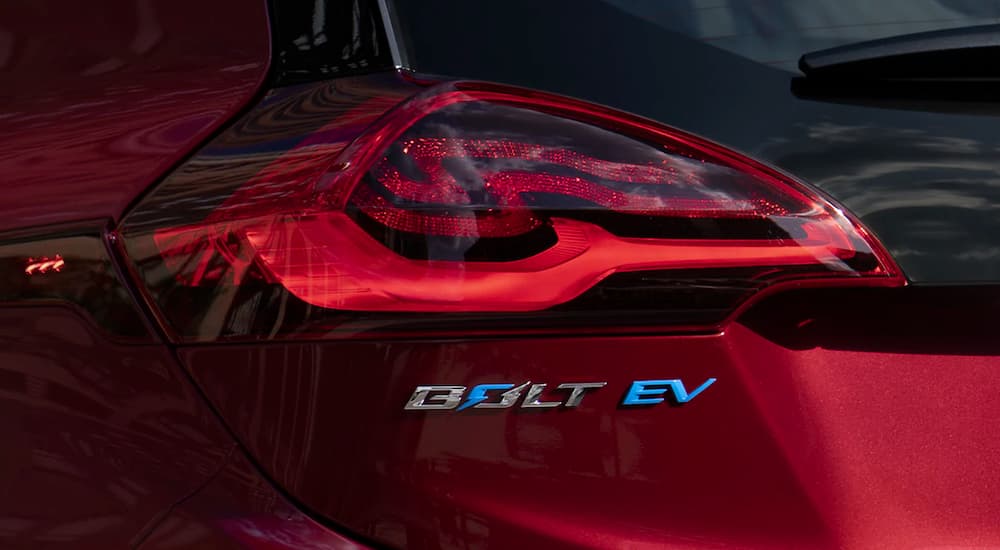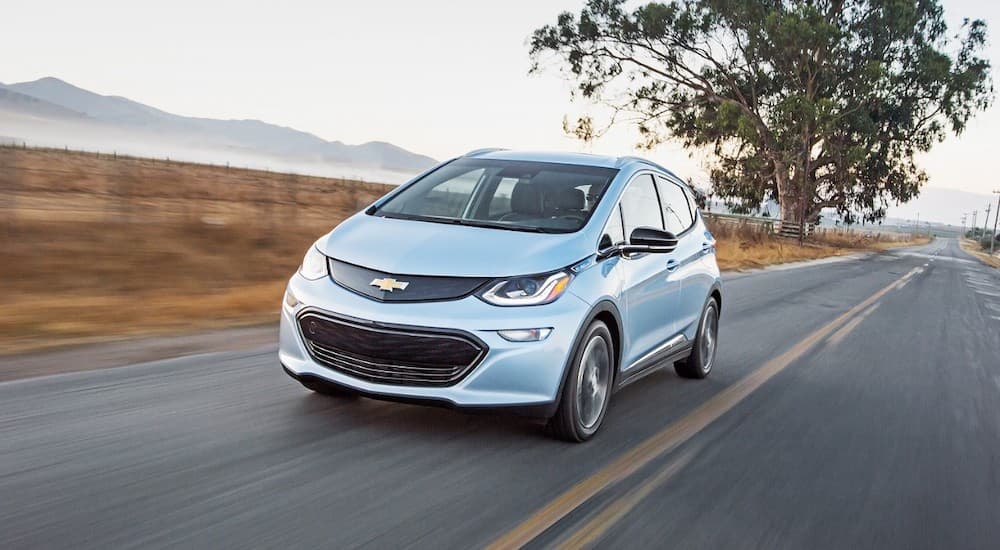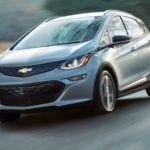The first electric vehicles were short-ranged, slow, and really only suited for city commuting. But that was then, and this is now. Just like its historied and dependable gas-powered line, Chevy is leading the pack when it comes to EVs with incredible performance, taking high-end tech and distilling it into more budget-friendly vehicles. Chevy was the first major manufacturer to offer a plug-in hybrid, and the upcoming Chevy EV models have first-in-class driver assistance and a brand new battery line. Long gone are the days of difficult charging, and the money you’ll save on gas is exponentially increased by not having to deal with regular oil changes, new spark plugs, or broken belts. Read on to learn how Chevrolet is taking electric vehicles to the future and why you need a Chevy EV.
Where We Came From
After testing modified Corvairs with electric motors in the mid-1960s and an all-electric car around the turn of the century, Chevrolet properly joined the electric market with the Chevy Volt in 2011. It debuted as a concept at the 2007 North American International Auto Show and was not just the first-ever plug-in hybrid from a major car manufacturer – it was the world’s first mass-produced electric vehicle with an extended range. The original Volt was able to travel up to 380 miles, and 35 of those miles were purely electric thanks to a long-life 16-kWh lithium-ion battery and 111-kW electric drive unit; the other 344 miles were courtesy of the Volt’s 1.4-liter engine.
Electric vehicles up to this point were electric only, which is an issue when you’re limited to planning drives around charging stations. But as a plug-in hybrid, the Volt bridged the transition to longer-range EVs. The Volt engine was no slouch either, going from 0 – 60 in under nine seconds and reaching a top speed of 100 mph. Finally, the Volt was easily charged from a standard 120-volt three-prong outlet in 10 to 14 hours, or from a 240-volt charging station in about four hours.
The Volt was a compact five-door sedan, comfortably seating up to four adults, and it was also designed to be more aerodynamic than any vehicle Chevrolet ever made. The Volt’s strut-type suspension and rack-mounted electric power steering system were taken straight from premium sport sedans. Paired with a lower center of gravity, thanks to its width and long wheelbase, the Volt drove like no electric car before: responsive, smooth, and agile. Production on the Volt finally ceased in 2019, largely in part because sales of sedans have been steadily declining in favor of SUVs and subcompacts – subcompacts like the Chevy Bolt EV.

Where We Are
The Chevy Bolt EV was introduced as a concept at the North American Auto Show in Detroit in January 2015. By the next month, just before the Chicago Auto Show, GM North American President Alan Batey announced that the Bolt EV was no longer just a concept: it was headed into production at GMs Orion assembly plant. Reaction to the Bolt EV concept had been so positive that Chevrolet decided to drive into the future as quickly as possible. Based on the lessons learned with the Volt and its industry-leading battery, the Bolt can get an EPA-estimated 259 miles on a full charge.
Besides the 120-volt standard outlet or a 240-volt special charging station, the Bolt can now also use DC fast charging, refilling up to 100 miles on a 30-minute charge. With the myChevrolet Mobile App with Energy Assist, you can easily find a public charging station and plan the most efficient routes based on traffic and weather to save the charge you have. The fully electric drivetrain has an advanced 66-kWh lithium-ion battery pack and a single motor and gearset with a permanent magnet drive motor, providing up to 200 horsepower. That provides plenty of pickup to move forward on green lights, easily merge onto the highway, and even climb steep hills. In addition, one of the benefits of an electric motor is that the power is there as soon as you want it – you don’t have to wait for the engine to spool up. As such, the Bolt EV can go from 0 – 60 in just 6.3 seconds.
An interesting feature of driving the Bolt EV is that you can do so with just one pedal. Thanks to a regenerative braking system, Chevy’s one-pedal driving means that when you release pressure on the gas pedal, it doesn’t just slow the acceleration; it actively increases deceleration, so you barely need to use the traditional brake at all. Now, of course, the proper brake pedal is never a bad idea and is definitely necessary at times, especially in heavy traffic. In addition, there is Regen On Demand – a paddle behind the steering wheel you can use to slow the car, transferring the kinetic energy of the moving car back into the battery, adding to the charge as you drive.
Of course, when you’re looking for a new car, electric or otherwise, you’re looking at more than the motor. The Bolt EV also comes with a 10.2-inch touchscreen giving you access to information on your battery and smartphone integration through Apple CarPlay or Android Auto. You can even add a 4G WiFi hotspot and use Chevrolet Marketplace to place a take-out order at a variety of restaurants or book a table to dine-in via Yelp. Despite its compact size and nimble handling, the Bolt EV is comfortable for even tall drivers and riders with over 36 inches of both headroom and legroom, even in the back seats. Those back seats also fold flat, allowing for 56.6 cubic feet of cargo space.
Where We Are Going
GM is bringing a whole fleet of EVs to the marketplace over the next few years, including four under the Chevrolet brand – one of those being a full-sized pickup truck. More on these to come, but for now, we do know that the Bolt EV will be getting not just an upgrade in the summer of 2021 but also a sibling, the all-new Bolt EUV. The upgrades to the Bolt EV for the 2022 model year will largely concern the interior, with less plastic trim, more comfortable seats, and an updated infotainment system. The driving will change a bit with the addition of adaptive cruise control and a push-button gear selection instead of the current gear stick, which should also allow for more centrally-located storage. The exterior will see a few changes to the front and rear styling for a sleeker look.
While the Bolt EV is comfy for a compact, the Bolt EUV, or electric utility vehicle, will bring a bit more size to your drive. Since the Bolt EV is already a tall hatchback, the EUV probably won’t be any taller, but it’s anticipated that the Bolt EUV will be five to six inches longer than the Bolt EV, on a wheelbase that’s three inches longer. So not only will the cabin be bigger, it should ride smoother, as well, like the difference between any hatchback and SUV. Besides the extra cargo space, there are multiple other perks, including a more luxurious interior, a standard sunroof, and sequential turn signals – a first in the Chevy family.
Perhaps the most important feature of the all-new Bolt EUV is that it will be the first Chevrolet vehicle to feature Super Cruise. Previously only available on Cadillacs, Super Cruise is the industry’s first truly hands-free driver assistance. Super Cruise uses precision map data and GPS, along with a network of camera and radar sensors and a state-of-the-art driver attention system to totally revamp the state of driving. Alerts are set for intersections, pedestrian crossings, and traffic lights to notify the driver to take back full control of the vehicle. Super Cruise can be used on compatible divided highways that GM has laser-mapped and approved for use, which is most of the major highways in the U.S.
While the 2022 Bolt EV and the all-new Bolt EUV will keep the same battery system as used in the current Bolt EV, future Chevrolet EVs will be using GM’s new Ultium batteries. These battery cells can be stacked in different ways within different battery packs, so they are more easily adaptable between front-wheel, rear-wheel, and all-wheel drive vehicles and for more than just compact cars and crossovers. Altogether, GM says the Ultium battery can make 19 different configurations and will be able to accommodate a range of up to 400 miles between charges. In addition, once the Ultium battery-powered motors are ready to be rolled out, they should cost about as much to make as the average traditional gas-powered motor, making Chevy EVs that much more affordable in the long run.
The EV in “ChEVrolet”
Electric vehicles are here to stay, and you can count on Chevrolet to bring you EVs that live up to the Chevy name. By starting with the compact Bolt EV and crossover Bolt EUV, Chevy is giving drivers what they want while constantly expanding the capabilities of the technology. EVs have come a long way since the initial models, and it won’t be long before they’re a major part of the market. Chevy has the technology and the experience to ensure each Chevy EV is state-of-the-art while also being accessible to the average driver. Chevy has always been “like a rock,” but now, you can get that rock to recharge.





